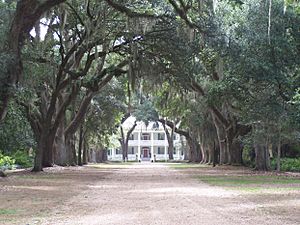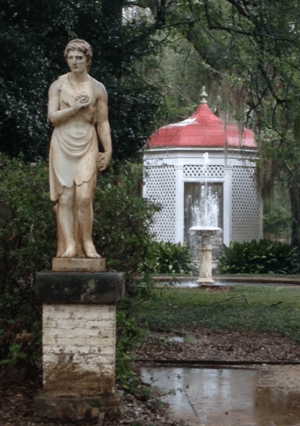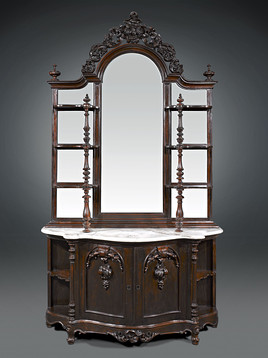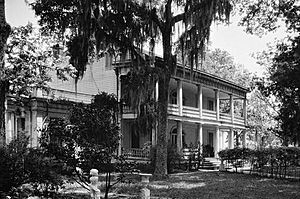Rosedown Plantation facts for kids
|
Rosedown Plantation
|
|

Rosedown Plantation
|
|
| Location | 12501 La. Hwy. 10, Saint Francisville, West Feliciana Parish, Louisiana |
|---|---|
| Area | 371 acres (150 ha) |
| Built | 1835 |
| Architectural style | Federal, Greek Revival |
| NRHP reference No. | 01000765 |
Quick facts for kids Significant dates |
|
| Added to NRHP | August 7, 2001 |
| Designated NHLD | April 5, 2005 |
Rosedown Plantation State Historic Site is a large historic home and former plantation in St. Francisville, Louisiana, United States. It was built in 1835 by Daniel and Martha Turnbull. Rosedown is known for its beautiful, detailed formal gardens that surround the house. It is one of the best-preserved plantation sites in the Southern United States.
Exploring the Rosedown House and Gardens
The Main House: Architecture and Design
The Rosedown house sits on the highest part of the plantation, near Alexander Creek. It was built in a mix of Federal and Greek Revival styles. The house is made mostly of cypress and cedar wood from the area.
It has two stories and faces west. A two-story porch with smooth columns and a fancy railing runs along the front. In the middle of the house, on both floors, there is a special doorway. This doorway has a curved top with leaded glass designs. In 1845, one-story brick sections were added to both sides of the house. These sections also have Greek-style porches.
The south side of the house has a porch with three columns. The north side, which is larger, has a porch with two columns. The columns on the ends of both sections are grooved, while the flat columns (pilasters) are smooth. The roof edges and decorations match the main part of the house.
Inside Rosedown: Rooms and Furnishings
The layout of Rosedown's rooms is in a French or Early Louisiana style. This is different from the American style, which usually has a long hallway through the middle of the house.
When you enter, you step into a main hall with special wallpaper from Paris. A curved mahogany staircase leads to the second floor. To the right is a parlor, and to the left is a music room. In the back, you'll find an office, a butler's pantry, and a dining room. The dining room has a "punkah," which is a large fan that was swung by a servant to cool the room.
Upstairs are the family bedrooms. The north section has a guest bedroom with its own bathroom. This bathroom had an early type of shower, with water coming from a tank on the roof. This bedroom was built to hold a special set of furniture. This furniture was originally meant for the Lincoln Bedroom in the White House for Henry Clay, if he had won the election in 1844. Since he lost, Daniel Turnbull bought the tall, fancy rosewood bed. This bed stayed in the room for over 150 years until it was sold to a museum.
The south section of the house holds a library. Daniel Turnbull used this room as his office to manage the plantation. The house was filled with furniture and items brought from cities like Philadelphia and New Orleans, and even from Europe. Many of the original pieces are still at Rosedown today. This includes a tapestry that was sewn by Martha Washington herself!
The Beautiful Rosedown Gardens
The Rosedown property now covers about 371 acres. The most important part is the 18 acres of beautiful gardens. These gardens were inspired by the grand formal gardens that the Turnbulls saw in France, Italy, and England during their travels.
Martha Turnbull, who loved gardening, carefully looked after these gardens for 60 years. She even kept a detailed diary about them. The gardens were started before the house was even finished. Records show that in 1836, plants like camellias and azaleas were bought from a nursery in New York.
You enter the gardens through a wooden gate. This gate leads to a long, 660-foot avenue of oak trees. This tree-lined path ends at a large oval area in front of the house. This area has a diamond-shaped garden bed (called a parterre) made of yaupon holly, with two large water oak trees beside it. The long length of the path is special because it matches an old way of measuring land using 66-foot chains. So, the path is exactly 10 chains long!
Along the tree avenue, there are eight white marble statues from Italy. These statues are not the original ones the Turnbulls bought in 1851, but they are very similar. On either side of the path, you'll find different garden styles. There are formal Baroque gardens with geometric shapes and English style gardens with winding paths. These gardens have many rare plants.
The sunniest part of the gardens is called the Flower Garden, located southwest of the house. It has many types of roses and a mix of straight and curved paths. One of the three fancy, onion-domed gazebos on the property is here. Nearby, there's an underground heated greenhouse (hothouse) and a brick tool shed. The other two gazebos are in the center of the large gardens on each side of the tree avenue.
In 1956, a landscape architect named Ralph Ellis Gunn helped restore the gardens. He added a pond and fountains to make the gardens even more beautiful.
Near the main house, there are several smaller buildings. These include a doctor's office (built like a small Greek temple), a milk-house, a wood shed, and a barn. Originally, the kitchen was in a separate wing attached to the back of the house. Another wing was added in 1859 for the Turnbulls to live in after their daughter Sarah took over the main house. During the 1956 restoration, the kitchen wing was moved and rebuilt near the house. The other wing, now called "Miss Nina's wing," was moved a few yards away to overlook the new pond.
The Story of Rosedown Plantation
The 1800s: Building a Cotton Empire
In the 1800s, the area around St. Francisville was mostly settled by British families. These families became very successful cotton farmers. Many of them had received their land from the Spanish government before the United States took over. Martha Barrow Turnbull's parents owned the land that became Rosedown. They became very important in the area because of their huge cotton farms. Daniel Turnbull, Martha's husband, was known as one of the richest men in the country before the Civil War.
Rosedown was named after a play the Turnbulls saw on their honeymoon. The land for Rosedown was bought in seven different parts by Daniel Turnbull between the 1820s and 1840s. At its largest, Rosedown covered about 3,455 acres, with most of it used for growing cotton.
Daniel and Martha started building the main house in November 1834 and finished it six months later in May 1835. The cost was about $13,109. The success and wealth of Rosedown came from the hard work of enslaved people. During the busiest times of cotton production, Daniel Turnbull owned 444 enslaved people, with about 250 working at Rosedown alone.
The Turnbulls had three children: William, Sarah, and James Daniel. James Daniel died young from yellow fever. William also died young in a boating accident. This meant their daughter Sarah inherited the plantation. Sarah married James Pirrie Bowman, and they moved into Rosedown. They had ten children. In 1859, Martha and Daniel Turnbull moved into a separate wing of the house to make room for Sarah's growing family.
Daniel Turnbull died in 1861, the same year Louisiana joined the Confederacy and the Civil War began. Rosedown and two other Turnbull plantations were badly affected by the war. After the war, Martha Turnbull managed Rosedown. Since they could no longer rely on the free labor of enslaved people, the family used the labor of 250 sharecroppers.
The 1900s: Keeping Rosedown Alive
Martha Turnbull passed away in 1896, leaving Rosedown to Sarah. After Sarah died in 1914, her four unmarried daughters — Corrie, Isabel, Sarah, and Nina — took over the plantation. In the 1920s, they decided to open the house to visitors. People were interested in seeing what was left of the rich cotton farming culture.
The sisters worked hard to keep Rosedown. When Nina, the last sister, died in 1955, there were no debts on the property. They still owned 3,000 acres of land and the house with all its original furniture. The family was Episcopalian, and they are buried in the Grace Church Cemetery in St. Francisville.
After Nina's death, Rosedown went to her nieces and nephews. In 1956, they sold the plantation to Catherine Fondren Underwood, who loved gardening, and her husband Milton Underwood. The Underwoods spent eight years and $10 million to restore the house and gardens to their original beauty. While the restoration happened, the plantation also worked as a cattle farm. Rosedown was opened to the public in 1964.
The 2000s: A State Historic Site
In 2000, the Louisiana Office of State Parks bought Rosedown Plantation. It became a state historic site. Its purpose is to show what plantation life was like in the 1800s. In 2005, Rosedown Plantation was named a National Historic Landmark.
Images for kids








